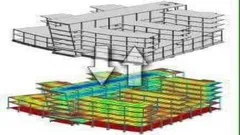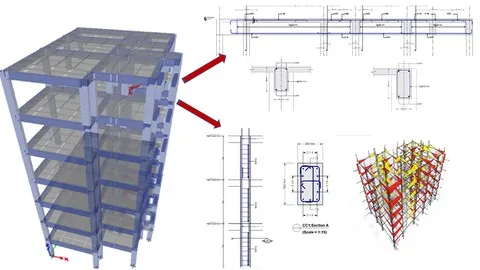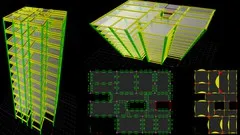
Revit & Robot From Zero to Expert 
Are you interested in becoming an expert in Revit and Robot structural analysis? Look no further! Join our comprehensive course, "Revit & Robot From Zero to Expert," where you will learn everything from the basics to advanced techniques. From drawing levels and grids to modeling and editing columns and walls, this course covers it all. You will also learn about analytical models, materials and preferences, and even how to export to Robot structural analysis and Etabs. Don't miss out on this opportunity to become a Revit and Robot expert. Enroll now and let's get started! Get a comprehesive understanding of Revit & Robot From Zero to Expert which is a pay course. AZ Class provides this course data for free. Learn more certificate and details here. ▼
ADVERTISEMENT
Course Feature
![]() Cost:
Cost:
Paid
![]() Provider:
Provider:
Udemy
![]() Certificate:
Certificate:
Paid Certification
![]() Language:
Language:
English
![]() Start Date:
Start Date:
2020-10-10
Course Overview
❗The content presented here is sourced directly from Udemy platform. For comprehensive course details, including enrollment information, simply click on the 'Go to class' link on our website.
Updated in [October 16th, 2023]
What does this course tell?
(Please note that the following overview content is from the original platform)
In this course you will learn the Revit and Robot structural Analysis from zero to expert.-you will learn how to draw levels and grids. -columns and walls modeling and editing. -Selection,zoom and hide and isolate. -Modify Tools and measure-Beam modeling and editing-Floor creation, slope arrow and sub elements.-Opening(vertical, by face, wall and shaft) -Import Autocad drawing. -Analytical Model (Rigid links, boundary conditions, supports, load cases and load combination) -Export to Robot structural analysis and Etabs. -Materials and preferences in Robot structural Analysis. -Selection, view, display, meshing and supports. -Design of all elements (Columns, beams, slab, raft, isolated and combined footing) -Return to Revit and model updating. So let's get started.
We considered the value of this course from many aspects, and finally summarized it for you from two aspects: skills and knowledge, and the people who benefit from it:
(Please note that our content is optimized through artificial intelligence tools and carefully reviewed by our editorial staff.)
What skills and knowledge will you acquire during this course?
During this course, the learner will acquire the following skills and knowledge:
1. Drawing levels and grids in Revit.
2. Modeling and editing columns and walls.
3. Selection, zooming, hiding, and isolating objects in Revit.
4. Using modify tools and measuring distances in Revit.
5. Modeling and editing beams in Revit.
6. Creating floors, adding slope arrows, and working with sub-elements in Revit.
7. Creating various types of openings (vertical, by face, wall, and shaft) in Revit.
8. Importing AutoCAD drawings into Revit.
9. Creating an analytical model in Revit, including rigid links, boundary conditions, supports, load cases, and load combinations.
10. Exporting the model to Robot Structural Analysis and ETABS for further analysis.
11. Understanding materials and preferences in Robot Structural Analysis.
12. Selecting, viewing, displaying, meshing, and adding supports in Robot Structural Analysis.
13. Designing all structural elements such as columns, beams, slabs, rafts, isolated footings, and combined footings in Robot Structural Analysis.
14. Returning to Revit and updating the model based on the analysis results.
By the end of the course, the learner will have gained expertise in using both Revit and Robot Structural Analysis software for structural design and analysis purposes.
Who will benefit from this course?
This course will benefit individuals who are interested in or working in the field of architecture, engineering, or construction. Specifically, it will be beneficial for:
1. Architects: Architects can learn how to use Revit and Robot for structural analysis, allowing them to create more accurate and efficient designs.
2. Structural Engineers: Structural engineers can enhance their skills by learning how to use Revit and Robot for structural analysis, enabling them to analyze and design complex structures more effectively.
3. Construction Professionals: Construction professionals, such as project managers or site engineers, can benefit from this course as it will provide them with a better understanding of the structural analysis process, allowing them to coordinate construction activities more efficiently.
4. Building Designers: Individuals involved in building design, such as interior designers or building consultants, can learn how to use Revit and Robot to create detailed models and analyze the structural integrity of their designs.
5. Students and Graduates: Students pursuing degrees in architecture, engineering, or construction-related fields can gain valuable skills and knowledge by taking this course, which can enhance their employability and career prospects.
Course Syllabus
Introduction
Levels and Grids
Columns and walls Modeling
Revit Tools
Beam and Floor modeling
Modify Tools
Measure
Opening
Revision
Foundation
Import Autocad
Analytical Model
Building Modeling and export
Robot Structural Analysis
Columns Design
Beam Design
Slab Design
Foundation Design
Revit Model update
Schedules
Bonus
Course Provider

Provider Udemy's Stats at AZClass
Discussion and Reviews
0.0 (Based on 0 reviews)
Explore Similar Online Courses

Mass Building using Autodesk Revit

Bridge Modelling with Autodesk Revit 2020 - BIM Tool Course

Python for Informatics: Exploring Information

Social Network Analysis

Introduction to Systematic Review and Meta-Analysis

The Analytics Edge

DCO042 - Python For Informatics

Causal Diagrams: Draw Your Assumptions Before Your Conclusions

Whole genome sequencing of bacterial genomes - tools and applications

Symmetrical building design Using ETAB Software

ETABS- Learn Building Analysis Design & AutoCAD Detailing


Start your review of Revit & Robot From Zero to Expert